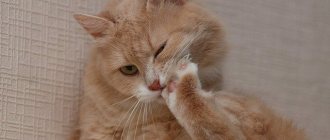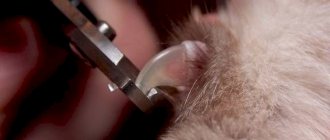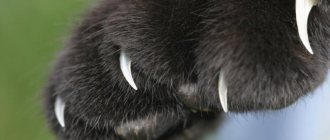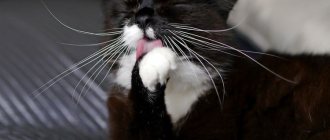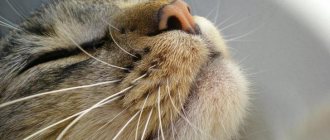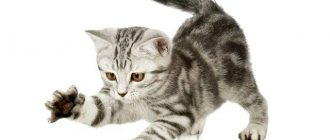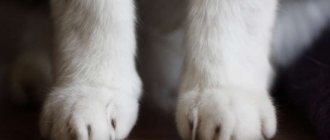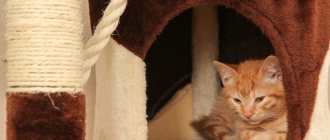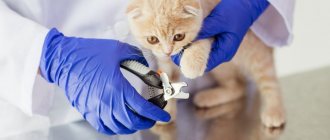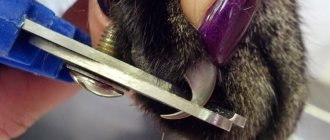Our fluffy and gentle pets have natural reliable protection. These are strong, sharp little claws. They can cause serious injuries to cats, which causes concern for many owners, especially if there are small children in the house. Special microorganisms (Bartonella bacteria) nest on the claws of cats, which, when released into the bloodstream when the skin is damaged, can provoke a disease - felinosis, cat scratch syndrome, benign lymphoreticulosis, cat scratch fever, Mollaret granuloma. Under all these complex and long names lies a very unpleasant infectious disease with inflammation of the lymph nodes, fever and severe intoxication. The disease requires the use of antibiotics for treatment.
Considering the possible health risks, as well as the passionate love of cats for scratching new expensive furniture, fresh wallpaper and expensive carpets, many owners come to the conclusion that something needs to be done about their pet’s claws. In the best case, special scratching posts are purchased for pets; in the worst case, they decide to have their nails cut or completely removed.
Before you make potentially dangerous and cruel decisions, you need to understand why cats need claws and what role they play in their lives.
Why do you need to cut your hair?
Nature has taken care of every living creature, and a cat’s claws were not given for beauty. In natural habitats, claws help a cat hunt for prey and escape from stronger opponents. With the help of its claws, the animal easily climbs a tree, escaping the dog and other enemies. But why do they need a domestic cat, who sees the whole world only from the apartment window?
Many owners believe that claws only bother a cat. And you can’t count how many troubles they cause for owners of furry pets:
- cling to carpets, curtains, upholstered furniture;
- During games, they can accidentally or deliberately scratch or injure a person.
Untrained cats often mistake a sofa, armchairs or carpet for a scratching post. And even if you place scratching posts in every room, the pet will leave marks of sharp claws on the furniture. There is only one way out - trim the claws so that they are not so sharp.
For animals participating in exhibitions, trimming their nails is a mandatory procedure. It is also recommended to do this:
- before mating;
- a visit to the veterinarian.
Small kittens, although they still have softer claws than adult cats, are also recommended to trim them so as not to injure the mother cat during feeding, and at the same time accustom them to manipulation. The sooner this is started, the less resistance the owner will encounter from the pet later during cosmetic procedures.
Important!
In no case should the claws of cats that have the opportunity to walk outside be trimmed: this can deprive them of the ability to defend themselves, which can lead to serious injuries and even death of the pet.
Is it possible to cut a cat's claws - pros and cons
So, is it worth trimming a cat’s claws and how to do it. Positive aspects:
- Pets are not able to sharpen their claws to the required length themselves. They grow very long in cats, this can easily lead to their ingrowth into the pads and delamination. If you don't trim your cats' claws, they will eventually interfere with their ability to move, regularly clinging to carpets, furniture and everything else.
- The need to trim nails most often arises only when they are very peeling or very injured.
- Quite often, before owners decide to trim their cat’s claws, they have time to say goodbye to the upholstery on the sofa, wallpaper in the bedroom, parquet flooring and jambs. All these things were ruined by the cat, and when guests arrive you can immediately see who’s boss.
- If there are children in the house, then the question of whether or not to cut the cat’s claws disappears by itself. Because a constantly scratched child leaves no choice for his parents.
- Before exhibitions, nail trimming is mandatory. This is an argument for those who own elite or purebred animals.
Opponents of this procedure provide no less weighty arguments:
- Even if the owner is fluent in the art of trimming cats' claws, injury cannot be avoided. Because the keratinized part is two or three millimeters long. After an injury, the claw can easily become infected.
- The nail trimming procedure itself can be very painful for a pet, since the claws contain all the nerve endings. Even if you know how to trim her nails correctly, be very careful because she will not have the best memories of the procedure. And this will need to be done regularly.
- Immediately after the claws are trimmed, they become less functional, and it will be very difficult for your beloved pet to cling to various objects. The animal will not immediately understand its limitations; it may try to jump somewhere and not be able to resist. So is it okay to have your cat's nails trimmed if it increases the risk of injury to your pet?
- After your pet has undergone this procedure once, you will have to do it regularly, twice a month.
- Now think about what will be more annoying, unpleasant periodic procedures or scratched furniture?
How often to trim your cat's claws
The frequency of the procedure depends on how quickly your cat's scratches grow. This is an individual indicator, but in all fluffies, the claws on the front paws grow faster than on the hind paws. Whether it's time to shorten them can be easily determined visually. The pet’s behavior will also indicate that it’s time to trim its claws: the cat will begin to sharpen its “scratches” more often and cling to everything with them.
Some pets get a manicure once every 2 weeks, others once a month. It is also worth considering that a cat accustomed to a scratching post may not need to have its claws trimmed very often. There is also no need to be zealous if the cat is preparing to move to a country house for the summer, where a free man awaits him. A released animal cannot do without a formidable weapon!
When trimming my cat's claws, my cat began to bleed, how can I stop it?
Any cosmetic procedure for an animal requires maximum attention and accuracy.
- Nail trimming is a traumatic procedure. The risk of injuring your pet is quite high.
- The reason for this may be a poor-quality tool, too large a cutting angle, touching the blood vessels in the claw, or simply your pet was scared of something and twitched.
- Similar cases can occur both in an experienced owner and in a novice.
If such a situation occurs, do not panic. Inspect the site of injury if possible. If the wound is shallow, treat it with hydrogen peroxide and bandage it, calm the animal. If you see that the bleeding does not stop, after pre-treatment, apply a bandage to the sore spot and, as soon as possible, contact a specialized clinic. The veterinarian will carry out all the necessary procedures and advise how to prevent a recurrence of the incident.
The main thing is not to panic
Nail trimming in the clinic
If the owner does not know how to trim a cat’s claws correctly, is afraid of hurting her, or simply lacks the determination, he should contact a salon or veterinary clinic. Once you find out how much it costs to trim a cat’s claws, you can choose a clinic. If the animal is very restless or the owner does not want to injure it, now you can call a professional to your home to trim the cat’s claws - the price for such a service is not too high, but you can be calm about the health of your pet.
Specialists will perform the unpleasant manipulation competently and as painlessly as possible and carry out all the necessary preventive procedures.
Thus, the question of whether and how to trim a cat’s claws is decided individually and depends on the physical condition, age and character of the animal. If you still decide to refuse a haircut, you need to prepare a suitable surface for the cat to sharpen its claws, because this desire is inherent in it by nature and is necessary for the normal development of the animal’s claws.
Features of the structure of cat nails and rules for cutting them
After checking the tools, you can slowly begin processing. The first step is to properly “set up” the pet itself.
How to prepare a cat
You will have to “catch” the right moment: it is advisable that the cat be a little tired, sleepy, or at least calm when the haircut begins.
But you can’t interrupt his games and almost forcibly start cutting - the natural reaction will be rejection, and the animal simply won’t give in to your hands a second time.
Important! The most practical tools are those with rubber lining on the handles. Your hand may slip off steel surfaces. Wanting to avoid unnecessary injuries (both to themselves and to the cat), some owners swaddle their pets
This is also a good method that is used before trimming a cat’s claws at home.
Wanting to avoid unnecessary injuries (both to themselves and to the cat), some owners swaddle their pets. This is also a good method that is used before trimming a cat’s claws at home.
This procedure will be unclear to the cat at first, and you should not expect him to immediately raise his claws. You will have to stroke the paws, slowly moving onto the pads, which lightly press down (until the claw appears). This simple method is especially useful for small kittens: they get used to it and there are no special difficulties with them.
At the very start you will have to calm and caress the animal. It’s also useful to talk - this kind of “explanatory work” also helps. Be patient, especially if you are dealing with an older cat.
Did you know? Trained cats can replace sniffer dogs. One of these professionals was Rusik, who in 2001–2003. helped find fish from poachers smuggling their catch through a police picket in Stepnovo.
Pruning rules
Before trimming a cat's claws, take a disinfected tool with clean hands.
Then proceed like this:
The paw is held firmly, but gently. It should not twitch or slip out. Lightly press the center of the pad with two fingers so that the claw is fully exposed. Now a little anatomy. If you look closely in the light, you can see the free edge of the claw and the pink tissue inside it. This is a pulp with nerve endings and vessels, we do not touch it. The edge is removed so that at least 2 mm remains to the pulp. If the cat has dark claws, you have to act by touch, in 2-3 approaches, cutting off 1 mm each time. At the same time, scissors or a trimmer are held from above and perpendicular, trying to trim “in one fell swoop.” This is a matter of habit - after a few sessions it will be faster. At the end of the procedure, we adjust the edges to make it more comfortable for the cat to walk without clinging to its paws.
Due to inexperience, you can injure your paw. It’s unpleasant, but don’t panic—fill it with peroxide and calm the “patient.” The bleeding goes away quickly.
There seem to be no difficulties, but for the first time you will need the help of loved ones who will hold the cat.
Important! In some breeds, the pads become very overgrown and the hairs cover the claw. A clipper can help here (of course, if the animal is not afraid of it).. Don’t forget to trim all the claws, 5 on the front paws and 4 on the back
Beginners often forget about this “asymmetry” and, without looking closely, leave an old claw in front, which over time causes discomfort to the animal.
Don't forget to trim all the claws, 5 on the front legs and 4 on the back. Beginners often forget about this “asymmetry” and, without looking closely, leave an old claw in front, which over time causes discomfort to the animal.
Best articles: Baobab - description and photo of a giant long-lived tree
Reward for good behavior
During the operation, do not forget to praise your pet, even if he becomes restless.
To smooth out the first stress a little, give him a vitamin, or even better, a treat you have prepared in advance (what your pet adores). This will slightly accustom the cat to the idea that a haircut is not so scary.
Find out what to do if you find your pet has problems such as ringworm or ear mites.
How to properly trim a cat's claws
Before you begin the exciting procedure, you need to make sure that the cat is in a good mood. The state of mind of the owner is also important. He must exude positivity, goodwill and at the same time – inflexibility and self-confidence. Under no circumstances should you fuss.
- Place a light near your work area so that you can carefully examine the claw, determining where the pulp begins.
- Wash your hands with soap, treat them with an antiseptic, and disinfect your chosen nail trimming tool.
- Gently sit the cat on your lap (with its back facing you), take the paw that you will treat first in your hand, and hold it firmly. If the animal begins to actively object, swaddle it in a towel or dress it in overalls. You may need to call an assistant to help.
- Gently press the center of the pad with your fingers to extend the claw to its maximum length.
- Place a nail clipper (scissors) on the curved part of the claw, choosing the correct angle - along the line of its growth, that is, the trimmed claw should not differ in shape from the untrimmed one. The cutting direction is from bottom to top.
- Stepping back at least 2 mm from the edge of the pulp, cut off part of the claw in one motion.
- If there are any rough spots left on the claw, you can get rid of them using a nail file, a diamond-cut file, or a whetstone. Just keep in mind that friction usually causes extreme irritation and anxiety in the animal. In addition, there is a risk of delamination of the claw if its edges are processed with excessive force. The pressure should be light.
- Trim all the claws, then give the cat a treat, even if she has not shown submissiveness.
Don't forget that the fluffy has 18 toes with claws (5 on the front paws and 4 on the back paws). At the end of the procedure, it is advisable to make sure that you have processed each one. One forgotten sharp claw can create discomfort for an animal.
Is there an alternative: “soft paws” and “anti-scratch pads”
In fact, there is only one alternative and how humane it is is the question. We are talking about an operation to remove claws - onychectomy. The need for it may arise in case of severe claw disease, traumatic damage to the fingers, or excessive aggressiveness of the animal. But in recent years, some animal owners are doing this without medical indications, but only to prevent their animals from damaging their furniture.
The glamorous name “soft paws” actually hides the amputation of the last claw phalanx on the animal’s toes. The operation is performed under general anesthesia, which in itself is a serious test for the animal’s body. Removal of claws can lead to a number of diseases and affect the psyche and behavior of an animal deprived of an innate tool, but not the need to use it.
A more humane method to prevent damage to hands and furniture is silicone claws or “anti-scratches.” These are silicone caps that are glued to the claw with special glue. They produce several sizes for cats of different ages and breeds, and all kinds of colors. Multi-colored caps not only allow you to be creative in choosing a manicure, but also make it easier to find and clean up fallen nails. The latter is especially true for families with small children and other animals who may pick up and eat something from the floor.
The gluing procedure is in many ways similar to trimming nails and is no less stressful for the animal. It should be taken into account that silicone pads change the animal’s tactile sensations when walking, playing, and affect jumping and the ability to climb objects.
Experts have differing opinions regarding silicone claws. On the one hand, there is no particular harm from them, and in comparison with “soft paws” they are completely harmless. But, on the other hand, for the animal it is stress and suppression of instincts.
Perhaps reviews from more experienced cat owners will help you decide on the need for the procedure. But remember that “anti-scratches” do not solve the problem at the root. It is still necessary to trim your cat's claws, as they continue to grow under the silicone.
How to circumcise?
Let's figure out how to trim a cat's claws correctly. First of all, we recommend purchasing special tools.
Circumcision tools
The owner should know that the claws cannot be trimmed with ordinary scissors, otherwise this may lead to problems. Pet stores sell claw clippers. Their shape ensures that the entire nail is captured. You may also be offered guillotine pliers for cat claws, which allow you to perform the trimming procedure more efficiently. If you haven’t been able to buy nail clippers yet, you can use guillotine-type nail clippers for human nails.
Cat declawing. Consequences
In addition to regular trimming of a cat's claws, there are radical methods - removing the animal's claws. Often, the reasons for such drastic methods are: damage to home furniture, aggressive behavior towards children. The operation to remove claws from cats is called onychectomy. Let's take a closer look at what such a procedure is and what possible consequences exist. There are a number of conditions necessary for such an operation:
- the animal must be domestic. Even if the opportunity to visit the street for a four-legged friend is given once a year - when traveling to the country - such an operation is contraindicated for you.
- If attacked by other animals, the cat simply will not be able to defend itself.
Danger often awaits residents of city apartments on the street
- Your four-legged friend must be healthy. The operation is performed under general anesthesia, which is already dangerous for the animal.
- Young felines tolerate this kind of intervention more easily.
- The young age of the animal helps it quickly adapt to the changes that have occurred and the rehabilitation process is more successful.
The operation itself involves removing the claw along with the adjacent part of the finger. If compared to a person, this is equivalent to removing the last phalanx of a finger. In other words, the animal obviously becomes disabled.
- The postoperative period in cats lasts about 3 - 4 weeks.
- The animal will be able to stand on its paws and try to walk only on the third day.
- All this time the pet will need care and attention.
- If the procedure was successful, the lameness will go away within a week.
- The entire time rehabilitation lasts, the cat suffers from unbearable pain, which painkillers can drown out.
Why trim a cat’s claws: is it necessary to do it?
Is it worth taking up scissors if there are special boards in the house? But many pets simply ignore them, and some, even paying attention to them, still strive to tear off the carpet or the owner’s sofa. The plates that scratch our skin and leave marks on all horizontal and vertical surfaces in the house grow throughout our lives
During this time they have undergone more than one update. To make this process happen as quickly as possible, animals sharpen their claws. In their natural environment, representatives of the cat family do this by climbing tree trunks and simply traveling - with their paws in direct contact with hard and dry ground. But furry homebodies do not have this. Therefore, they spoil what is not intended for such procedures - furniture, carpets and other interior items
The plates that scratch our skin and leave marks on all horizontal and vertical surfaces in the house grow throughout our lives. During this time they have undergone more than one update. To make this process happen as quickly as possible, animals sharpen their claws. In their natural environment, representatives of the cat family do this by climbing tree trunks and simply traveling - with their paws in direct contact with hard and dry ground. But furry homebodies do not have this. Therefore, they spoil what is not intended for such procedures - furniture, carpets and other interior items.
Another reason why pet owners decide to get a haircut is numerous scratches. Also, do not forget that the tips of the ridges grow, and then they can break, bend or flake.
Mechanical damage to the plate during walking, playing, or an unsuccessful procedure to remove the keratinized end can lead to bleeding and severe pain. By retracting such a claw, the animal injures the so-called security hole, after which inflammation develops and swelling appears. Be careful and monitor your pet's behavior. If the overgrown plates are too long and constantly cling to your clothes, carpet pile or furniture upholstery, take your pet to a veterinarian who will tell you how to avoid injury.
Another reason why owners sometimes have to pick up scissors is the existence of a fifth claw. It is located on the side of the front legs and differs from others in that it does not scratch, but is actively growing. If it reaches a certain size, the cat will experience discomfort when walking.
We found out whether it is possible to trim cats’ claws, but is it necessary to do it yourself if there are other options that are more gentle? If you don’t want to spend money on buying special houses and posts and are confident that you will do everything right, you can try to “disarm” your pet. Otherwise - if you know that you will not be able to hold the cat, and are afraid of hurting him by damaging the plate - it is better not to risk it.
How much does it cost to trim nails at the vet?
Nail trimming in a veterinary clinic is a guarantee of a high-quality and safe procedure. Doctors use professional nail clippers with particularly sharp sharpening. A grooming salon can also help with this manipulation.
The average price of a haircut in Russia is about 300 rubles. In some small clinics, claws can be trimmed for 50 rubles, and in large centers the cost of cutting claws reaches 350-500 rubles.
If the pet is aggressive, and the owner cannot restrain it himself, ensuring the safety of the doctor, additional restraint may be required, which is paid for in most veterinary institutions.
Other solutions
Cats have a natural instinct - they take care of their claws themselves. Starting from the age of one month, kittens sharpen them with their teeth, scratch the bedding, use a scratching post or other objects, removing the dead outer shell of the claw.
To preserve furniture and other interior items from damage, owners are looking for various options. A good method of training and protecting furniture is a scratching post. You can buy it at a pet store or make it yourself. A board or post with a rough hard covering is installed in a place accessible to the pet. If you teach your kitten to use the device from childhood, you can keep the sofa and wallpaper in the room.
Pet stores sell special silicone claw covers. Their advantage is that the cat can calmly play with small children and sharpen its claws on any surface without fear of leaving damage. However, it is not recommended to use them for a long time, and even more so, you should not put the pads on animals that are walking on their own: in case of danger, the cat will not be able to climb a tree or rise to a different height.
Best articles: Description, distribution and features of the Mediterranean climate
The most cruel decision of the owners is to remove the claws. In most countries of the world, this manipulation is strictly prohibited and is punished as cruelty to animals. During the operation, not just a claw is removed, but part of the phalanx - almost the same as cutting off a person’s fingers. This cripples the animal and makes it disabled.
After onychectomy, performed under anesthesia, which in itself is dangerous for the cat, the structure of the skeleton is disrupted, and this negatively affects the functioning of all body systems. The cat is not only exposed to stress and danger - its coordination and sense of balance are impaired, it can fall even from a small height and be seriously injured.
Animals' character changes, they become irritable and even aggressive. Therefore, it is much easier to teach a kitten to use a scratching post from an early age and regularly trim its sharp claws.
Something sharp with the letter “k”: features of the anatomical structure
Opponents of such an extreme measure claim that it is painful for the animal, because during the “execution” it experiences nothing but pain and fear, and frequent cutting can lead to damage to blood vessels. Is it so? Let's turn to anatomy to make sure that not everything is so simple.
We all know that the claws are located on all four legs of the beast, which can control them like Wolverine from Marvel comics - retracting and releasing. In the first case, they are hidden in the folds of the skin. At such moments, the cat’s paws are soft - nothing threatens both you and your furniture.
An interesting fact is that cheetahs, although they belong to the cat family, differ from all their counterparts, including domesticated ones, in that their claws do not retract.
The claw is hidden under the influence of a tendon, which also allows the cat to release the tip, which is dangerous for home textiles and your hands, when the animal is excited or ready to attack its prey.
The claw is shaped like a sickle - which is why it is so convenient for them to hold something and injure the enemy during a fight. The part that we see consists of the living part and the stratum corneum. The first contains the processes of nerve fibers and blood vessels, the second is subject to grinding and is shed from time to time, like an old snake skin.
So all the fears of those who oppose cutting are quite logical and justified. The plate must be cut carefully so as not to touch the nerve endings or damage the translucent vessel.
Pets belonging to some breeds may have serious problems with their claws: they can peel off and grow until it begins to cause discomfort to the animal. Most often, this happens to Persians if they lack vitamins B or D. If you have a Sphynx or other hairless cat, you need to check your pet’s paws for the formation of a secretion produced by the sebaceous glands - it accumulates in the comb bed and is removed every three days .
Can a cat have its nails trimmed and why?
The need to sharpen a cat's claws is genetic. However, most city pets spend most of their lives indoors. Consequently, they do not lead such an active lifestyle as their wild counterparts. However, the need to grind down the claws remains. Owners of domestic cats are accustomed to watching their pets independently solve problems with their claws - sharpening them wherever they want. The following are used: furniture upholstery, short-pile carpets, wallpaper on the walls and even the jambs of wooden doors are “attacked” by furry predators. Damage to upholstered and other furniture in the house is a serious reason to monitor the condition of an animal’s claws.
Damaged furniture is the result of ignoring the needs of the animal
Their special structure speaks in favor of caring for cat claws. As you know, the fifth claw on the front paws is separate from the other four and is inactive. However, it is necessary to monitor its length to prevent the claw from growing into the skin. Which can cause discomfort to the animal. This claw does not need frequent length correction; it can be trimmed along with the rest. A broken claw is also a reason to trim it. You can and should trim your cat's claws. After all, the health of the furry pet depends on the patience and attentiveness of the owner.
Conclusion
Do I need to trim my cat's back claws? Many cat lovers ask whether it is necessary to cut the claws on a cat’s hind legs? Veterinarians advise performing this procedure, but less often than for the front paws. This is due to the fact that cats have shorter claws on their hind paws than on their front paws.
Veterinarian advice on cat nails: trim or remove?
Home \ Advice from veterinarians \ Advice from veterinarians regarding cat nails: cut or remove?
CAT CLAWS
Unfortunately, many veterinary clinics now provide a DECLAW REMOVAL - that is, the area of the toe responsible for the growth of the claw is removed. Many owners of domestic cats easily undergo this operation without knowing or imagining what the risk is for the cat. For veterinarians, this is a business - the operation is quite expensive - so not all of them explain the consequences to animal owners. And driven by good intentions, in ignorance, people make cats disabled! Recently, the practice of trimming cats' claws has become widespread, and in the West even removing them completely. This article from the Auckland Society Against Cruelty to Animals (SPCA) website argues for cat owners to find an alternative to declawing their cats. If you are planning to trim your pet's nails, please take some time to review the information contained in this article. Claws are very important for a cat. The legendary grace and agility of cats, their sense of balance, are largely due to the movable structure of their claws, which assume specific and different positions when walking, running, jumping, climbing a tree, digging, etc. Claws are also the main means of defense. The need for scratching. The outer portion of the claw gradually wears down, so the cat scratches at suitable surfaces to remove the worn portion of the claw, revealing a smooth, sharp new claw tip. Scratching is also a way of demonstrating a very strong instinct - marking one's territory. At the same time, the cat not only leaves visible marks - traces of scratching, but also applies the secretion of special glands to the scratched surface, the smell of which is smelled by all cats. Scratching helps the animal maintain psychological balance, feel comfortable in its territory and train the corresponding muscles. Declawing surgery. The standard procedure is to trim the tip of the claw. In the West, an operation has become widespread in which the area of the toe responsible for the growth of the claw is removed. The operation is usually performed on the front legs. In fact, this is equivalent to amputating the last phalanx of the fingers in humans. The healing and rehabilitation process is very painful for cats. I don’t even want to translate the part of the article describing the medical complications after such a knackering procedure, thank God, our people have not yet reached such barbarity. Please note that even cutting off the very tip of the claw can cause longitudinal cracks and disruption of the correct growth of the claw, which, in turn, can lead to very serious consequences for the animal. Behavior. Although there have been no formal studies of behavioral effects, owners and veterinarians have noted changes in personality in declaw-trimmed cats. Previously active, friendly animals become unsociable and withdrawn. Often, deprived of their usual means of defense, they become nervous, frightened, and/or aggressive, constantly using the last remaining weapon - their teeth. Constant stress caused by a feeling of defenselessness can lead to weakening of the animal's health. Some cats stop using their litter box; it may be associated with the discomfort experienced when trying to “bury” the filler.
Safety: Cats that have been declawed should not leave the premises—their ability to defend themselves or to escape from danger is seriously impaired. Even in an apartment, a cat without claws is at risk. Declawing causes weakening of the muscles in the paws, legs and even the back; the sense of balance also decreases. Combined with the loss of normal dexterity provided by the ability to instantly grip the surface with claws, this leads to the fact that an animal without claws can easily get injured.
An alternative to declawing. Scratching area: Make a post out of scrap material that your cat can sharpen her claws on for fun, and place it in an easily accessible place so that it won't wobble when scratching. The covering should be hard and rough - an old carpet, a tattered felt boot will do, or you can simply wrap it with rope. If you don’t want to do this, such devices are sold at any pet store. If you want to wean your cat from scratching furniture, place the post so that it is in sight of the cat, and gradually move it as you get used to it. Train your cat: while forbidding her to scratch objects not intended for this purpose, be sure to show her what she can scratch. If you notice that the cat is about to scratch the furniture, say “NO” loudly and firmly and move it to the designated area. Place her paws on the post and make a couple of movements with them. If the post is high enough, you can simply sit the cat on it. A water pistol is good for weaning a cat off a bad habit. Every time you show the place, or the cat uses it itself, praise, pet the cat or play with it. You can lightly rub the column with catnip or valerian. At the same time, make your cat's favorite furniture less attractive to her: stick it with adhesive tape or cover it with a soap-scented blanket. Nail care: Regular nail treatment, manicure, so to speak, significantly reduces the consequences of scratching for furniture and the hands of the owners. To do this, it is enough to trim the very tip of the claw, no more than a millimeter, like a person’s nails, and in the same way as a person, with tools specially designed for this. It is better to teach this procedure from kitten age, then, as cats grow up, they even find pleasure in it. When you are first training your cat, start trimming when she is calm or even dozing. Trim only one nail at a time. Talk and praise the cat while you are cutting it and reward it with something afterwards. Be sure to carry out the first haircut in the presence of a knowledgeable person, preferably a veterinarian.
Never use scissors for this, but only special tweezers. Scissors can cause damage to the claw - longitudinal cracks and scuffs.
Hold the pliers perpendicular to the nail being trimmed. Be careful not to touch the sensitive area of the claw; the distance to it should not be less than three millimeters. If you hit this area, your cat will be in pain and may even bleed. If you continually trim the nails too close to the living part, it may shrink.
Where do cats get their nails cut?
Of course, the most budget-friendly option is to trim your pet’s claws yourself, at home. If you have no experience at all, read our article to the end. A specialized store will help you choose a nail clipper. Or choose scissors for cutting cat claws from the catalog in the Aliexpress online store using this link.
Some nuances can be suggested by friends who have animals and have the necessary experience.
If you still lack self-confidence, you can turn to professionals. Specialists in the field of animal care and hygiene are called groomers, and their specialty is grooming. There are salons of the same name where you can bring your pet. The pricing policy here depends on the services provided, the reputation of the store and other factors. You should trust the master not only because he will be able to carry out all the necessary manipulations efficiently. There are cases when, during the process of trimming, cats try to escape, for example, if they have not been accustomed to such a procedure since childhood. In this case, the help of a professional will save you from both physical and moral trials. It will protect your pet from unnecessary stress.
Sometimes four hands are better than two
Most often, owners who participate in various exhibitions, competitions, and photo shoots resort to the services of a specialist. Sometimes, the level of such events requires certain standards of appearance. Participants in such competitions become regular clients of grooming salons.
Sometimes a master’s creativity knows no bounds
How to prepare for the first procedure
Learning how to trim a cat's claws correctly is not difficult, but it is important to prepare thoroughly in advance. Initially, immediately choosing a convenient tool for carrying out the pruning procedure is quite problematic and you cannot do without tips from specialists.
As a rule, several types of tools are used. Each owner selects the correct appropriate pruning method individually. To trim a cat's claws, I use both regular scissors and those from a manicure set.
If this is your first time trimming your cat’s claws, we recommend that you use our tip and prepare thoroughly. Some owners find it convenient to carry out the procedure using nail clippers. Specialized tools used in veterinary medicine are special scissors for cats - blister, as well as guillotine trimmers.
It is also important for the owner to stock up on a special wool clipper. This will remove excess hair that grows between the cat's pads and toes. It is necessary to have cotton pads and special medications on hand that stop the blood - hydrogen peroxide, tannin or a hemostatic sponge.
In order to carefully file down the cut claw, you will need a manicure file or buff. Before trimming your cat's claws, it is important to choose a convenient tool.
It is recommended that the animal have its own tools for hygiene procedures.
This will reduce the risk of infection if the owner accidentally injures the pet’s fingers during nail trimming.
There are two basic types of nail clippers available in specialized pet stores. They can be guillotine-shaped or crescent-shaped. Sickle-shaped nail clippers for cats are intended for those pets whose plates are unusually strong and it is problematic to cut them with ordinary scissors.
A guillotine trimmer is preferable, since the cut after processing with the tool is much neater and practically does not require further processing with a buff or file.
Experts recommend choosing a high-quality device made of stainless steel and with special silicone handles. This makes it possible to extend the service life of the nail clipper, and its use will be as convenient as possible for the owner, since it will not slip in the hand.
How to cut your hair correctly
You can start trimming your kitten's nails as early as 2-3 months of age. At this time they are still soft, by six months the claws harden. A convenient time for cutting is after feeding and playing. The kitten wants to sleep and will not resist, so the procedure will be harmless for both the animal and its owner.
Advice!
To accustom a kitten, during games and petting, gently stroke its paws, massage the pads, lightly pressing on them and stimulating the appearance of claws.
For the procedure, it is best to purchase a special nail clipper, but you can also use regular nail scissors or tweezers. Scissors are not always convenient - trimming hard nails on adult pets will require effort. It is not recommended to use scissors with rounded ends, as they can injure the paw pads.
In addition to scissors, you need to prepare a nail file, a cotton pad and oxygen peroxide - they will be needed in case of possible injuries to disinfect and stop bleeding.
If the kitten has been accustomed to the procedure since childhood, you can handle it alone; if it actively resists, it is better to attract an assistant to calm and hold the cat to avoid injury. Particularly active ones can be swaddled during cosmetic procedures, but if the cat desperately resists, it is better to postpone the manipulation or have it done in a veterinary clinic.
Important!
On the front paws, you need to trim the claws at least twice a month; on the hind paws, once is enough.
Before work, disinfect tools and wash your hands thoroughly. Choose a bright place in the room, calm the cat, then take its paw in your left hand, press the pad: the pet will release its claws
Please note that in cats, blood vessels and nerve endings are located very close to the regrown part of the claw, so trimming should be carried out no closer than 2 mm to the pink part of the claw. If the claws are too hard, you can lightly file the edge.
At the pet store you can buy a special tool for caring for cat claws - a nail clipper. It has a curved shape and makes the procedure safe. There are several types of nail clippers:
special nail clippers-scissors. They cover the perimeter of the claw and prevent damage. forceps
They have a limiter that does not allow cutting off too much of the claw, and they make a high-quality cut, eliminating the delamination of the claw plate; “guillotine” – must be used with caution, since it is difficult to control the manipulation; electric grinder. A professional tool for groomers and veterinarians.
Best articles: Rare plants from the Red Book of the Stavropol Territory - list, characteristics and photos
It is most convenient to use forceps, directing their movement at an angle, so that after trimming the claw has a sharp end, similar to an “arrow”. Before doing this, carefully examine the claw to determine where the blood vessel is located. If it is accidentally damaged, treat the wound with hydrogen peroxide.
After manipulation, lightly polish the sharp edges of the claw with a nail file. After the procedure, be sure to pet your pet and treat him with his favorite treat. Then he will develop a good instinct, and the cat will not perceive the following manipulations as something unpleasant.
Important!
Some breeds require more frequent nail trimming. In Persians and Sphynxes they grow much faster, so you should regularly inspect your pet’s paws and decide whether to cut it or not.
It is difficult to accustom some animals to hygiene procedures. It is not always possible to calm them down with affection or treats. Sometimes aggression during trimming a pet's nails is explained by the fact that he was once hurt. As a result, an instinct has developed, so it is recommended to either cut such animals together or carry out cosmetic manipulations in a veterinary clinic. Specialists know how to find an approach to any animal and will trim the claws of even the most obstinate cat.
LiveInternetLiveInternet
Why is it dangerous to trim a cat's claws?
Sharpening a cat's claws is a natural need.
From the first month, as soon as they stand on their paws, kittens learn to care for their “scratches.”
They sharpen and even gnaw them, scraping off the upper, old dead stratum corneum of the claws.
In nature, overgrown claws wear down from running and climbing trees.
But a domestic cat that leads a sedentary lifestyle, either because there is nowhere to turn around, or because it is sick or is already old, may grow too long claws.
And many owners, trying to reduce the “damage” caused to furniture by their furry pet, regularly trim its claws.
By the way, you can stop a cat from scratching furniture in other ways - How to stop a cat from scratching furniture?
It must be said that cutting a cat’s claws must be done with great care, since only the tip of the claw is devoid of blood vessels and nerve endings (pulp). It is the tip that is removed when the cat “sharpenes” the claws in the form of a whole “case” that follows the shape of the claw.
If the claws are pigmented, i.e. black, then the pulp is not visible, but if transparent, then it is quite noticeable.
Damage to the pulp is fraught with bleeding and even inflammation. If an infection was introduced during the cutting process, then the nails will grow sick, weak, and split. So, you can trim furry claws only if the blood vessels do not reach the tip.
It must be remembered that as the claw grows, the pulp also lengthens, so cutting the claw to a “normal” length in this situation can easily damage it.
Do not forget also the factor that cats, cats, when visiting the toilet, use their paws, and not toilet paper and the toilet (although, I heard, there are such unique cats). Therefore, with injured claws, there is a guarantee that your cat will pick up some kind of any infection - very high.
It is better to trim the nails so that they are slightly longer than usual, and trim them again after a couple of weeks.
How to do this correctly, watch the video:
When you decide to trim your cat's claws, remember that with trimmed claws, your pet will not be able to do many things - climb onto window sills and cabinets, climb on the carpet...
Such a limitation of opportunities is unlikely to have a positive impact on her character.
And, in addition, the absence of claws on a cat can lead to injuries.
Imagine: when jumping, a cat will habitually try to catch the surface with its claws, but since the claws are trimmed, it will not hold on and fall to the floor.
Is it worth exposing her to such a risk?
And in general, cutting a cat’s claws just to protect yourself from accidental scratches and to protect sofas and wallpaper is a meaningless undertaking.
At the first opportunity, your purr, succumbing to instinct, will sharpen its claws again.
Cat claws:
And so that you don’t have conflict situations with your cat because of torn wallpaper, I’ll give you some advice. Bring a small log from the street (approximately 50 cm long and about 45 cm in volume), preferably covered with thick bark.
Believe me, your cat will appreciate your gift and care, and “cat raids” on furniture and wallpaper will stop forever :).
What about nail trimming? My answer is simple: you shouldn’t trim cats’ claws.
But brushing your claws once a week is very useful. You can use an old toothbrush and soap for this.
See also:
Trimming cat claws
How to CORRECTLY give a pill to a cat
Homemade scratching post ideas
Mr. Cat warns: when should you not cut your cat's claws?
Trimming claws is not recommended for very young kittens under 4 weeks of age, or for older pets who move very little and prefer a recumbent lifestyle. In all other cases, the procedure can and should be performed.
How to train a cat to be trimmed
Veterinarians advise starting to accustom the animal to this procedure from a very early age. The first time this procedure is done is when the kitten reaches three months of age.
An indispensable condition is to perform this procedure with the utmost care so as not to cause any pain to the baby. Otherwise, in the future this process will turn into torture for everyone.
It is advisable to do this procedure with an assistant.
The time for grooming should be chosen so that the kitten is calm. You can treat him with a treat, pick him up, caress him
And then carefully trim the claws
Preparation for the procedure
Who else but the owner knows the habits and character of his beloved pet, so he can adapt to it. Nervous, aggressive animals react ambiguously to any procedure. It will be good if 2 people cut the cat’s claws. A cat that is struggling should not be forced, otherwise trimming its claws can lead to injuries on both sides. You just need to wait for the animal's favor before attempting to trim the nails again.
Accustoming an animal to procedures usually begins at the age of a kitten. A small pet should not be afraid of having its paws touched. To trim claws, you should prepare the tools and place them on the table. It is recommended to take the cat in your arms, stroke its back, touch each paw so that it calms down. If the pet is unfriendly and wants to run away, there is no need to forcibly restrain it. It is impossible to do the procedure in this condition; it is advisable to wait 2-3 days.
If the cat behaves peacefully and does not resist touching, it is worth praising it and giving it a treat. He will get used to getting food for this and will allow you to touch his paws. You should talk to your pet, at the same time stretch your fingers one by one, and at the same time inspect the claws. A cat that trusts its owner will not interfere with such manipulations.
Why trim your cat's claws?
Long claws on a cat
Cats' claws grow throughout their lives, and in order to regulate their length, animals are forced to constantly grind them down. Yard cats and pets that their owners let outside solve the problem of overgrown claws by grinding them off on asphalt or trees.
And domestic cats have no choice but to sharpen their claws on wooden surfaces, walls and door frames. The result of such “hooliganism” is known to all owners of furry pets: torn wallpaper, hopelessly damaged upholstered furniture and traces of scratches on the doors of cabinets and bedside tables.
If there is no scratching post in the house, then torn wallpaper and sofas will not take long to appear!
To protect furniture, curtains and wallpaper from the sharp claws of a pet, owners have two options - either purchase a scratching post or regularly trim the cat’s claws.
A scratching post can only partially solve the problem of a pet’s overgrown claws, because there is no absolute guarantee that the cat will sharpen its claws exclusively on it.
Benefits of claw trimming
The question of whether a cat’s claws need to be trimmed is a top priority for owners, and many decide positively. Compared to removal, this method is still much more humane, and the cost of declawing a cat is quite high. Firstly, pets cannot grind their claws down to the desired size on their own; they grow too long and can peel off, become ingrown and injure their paw pads.
In addition, cats have a so-called fifth claw located on the back of their front paws. This nail always grows freely, without participating in the cat’s scratching, and therefore she does not have the opportunity to sharpen it.
If you do not take care of the animal's claws and do not trim them if necessary, the fifth claw can begin to grow in and cut quite painfully into the pads of the paws.
There is no need to cut it too often; it is enough to do it during the main procedure.
Secondly, we cannot ignore the everyday side of the issue. Almost all owners of domestic cats have had to live in an apartment with peeled wallpaper and sofa upholstery, scratched furniture and flooring.
Thirdly, the question of whether it is possible to cut the nails of cats is always answered in the affirmative by owners of purebred animals - such a haircut is a necessary procedure before exhibitions. Pedigree kittens often have their claws trimmed in the first week after birth.
Finally, this procedure is simply necessary if there are children in the house - whether cats can have their claws trimmed varies from owner to owner, but the child must be completely protected from possible injuries. Or, instead of cutting the claws, you can try putting special caps on the cat.
How to trim a cat's claws at home?
Now that a lot of information has been collected, when all familiar cat owners have been interviewed more than once, it is necessary to summarize the knowledge gained. Here are some tips before starting the procedure:
- First, calm down and set yourself up for a positive result. Animals, like children, are very good at capturing and transmitting our state. Your panic may be passed on to your beloved pet. Which can lead to a number of complications during the haircut process.
- It is advisable to carry out all manipulations with nails from an early age of your pet. Claw care will become a habitual ritual and the animal will not be afraid of it. In addition, this will have a positive effect on the health of the four-legged animal. After all, as we know, prevention is better than cure.
- It is better to carry out nail correction when your furry friend is in a calm or even sleepy state. In any case, before you start work, take a closer look at the animal - it is the same participant in the procedure as you are.
- Prepare everything you might need in advance:
- Claw cutter - you have already decided on the choice of type.
- High rigidity nail file - cat claws are much stronger than human claws.
- Hydrogen peroxide and cotton swabs - in case of a possible wound.
- Light - the room should be well lit - you should clearly see the entire nail area to prevent injury.
Description of the haircut procedure at home
Of course, you need to decide how often to cut a cat’s claws based on its physical condition and development, but on average this is done once every two weeks. It is better to accustom your pet to this procedure when he is still small, then cutting will be quite common for him and the animal will no longer be afraid. If you are in doubt whether your cat’s claws can be trimmed at this time, you should take the paw, lightly press on it and examine the claw that comes out - if it is sharp and long enough, you can cut it.
When talking about how to trim a cat's claws at home, you need to start with the fact that during the trimming the cat should be sleepy or at least in a calm state. But some animals, despite all the efforts of their owners, cannot get used to useful hygiene procedures. In this case, it is better to swaddle the cat so as not to accidentally injure yourself or her. It would be good to have an assistant in this delicate matter. You can also treat your pet with a treat or vitamins.
Before cutting your cat's claws, you need to prepare and sterilize the tool. It is difficult to handle this with ordinary scissors; it is better to purchase a special nail cutter (trimmer) at the pet store, adapted to the shape of the animal’s claw. You also need to prepare cotton wool, hydrogen peroxide or another antiseptic - before trimming your cat’s claws at home, you need to take care of its safety.
After preparing the necessary tool, you need to hold the animal’s paw in your hand, carefully but firmly so that it cannot escape, lightly press on the center of the pad so that the claw opens. It is also advisable to wipe the claw with a disinfectant tonic. When cutting (of course, it needs to be done in good lighting), you must be careful not to touch the pink pulp; you can only cut off the keratinized gray layer.
Then you need to clamp the claw in the nail clipper so that there is at least a millimeter to the edge of the pulp. The device must be held perpendicular to the surface of the claw and paw. After trimming, file the tip of the claw using a regular nail file.
If, nevertheless, the claw is injured and bleeding occurs, there is no need to panic; the wound must be treated with hydrogen peroxide and the animal must be calmed. The nail may still bleed for a while, but after a while the bleeding will stop. And at the end of the procedure, be sure to treat your pet with something tasty.
